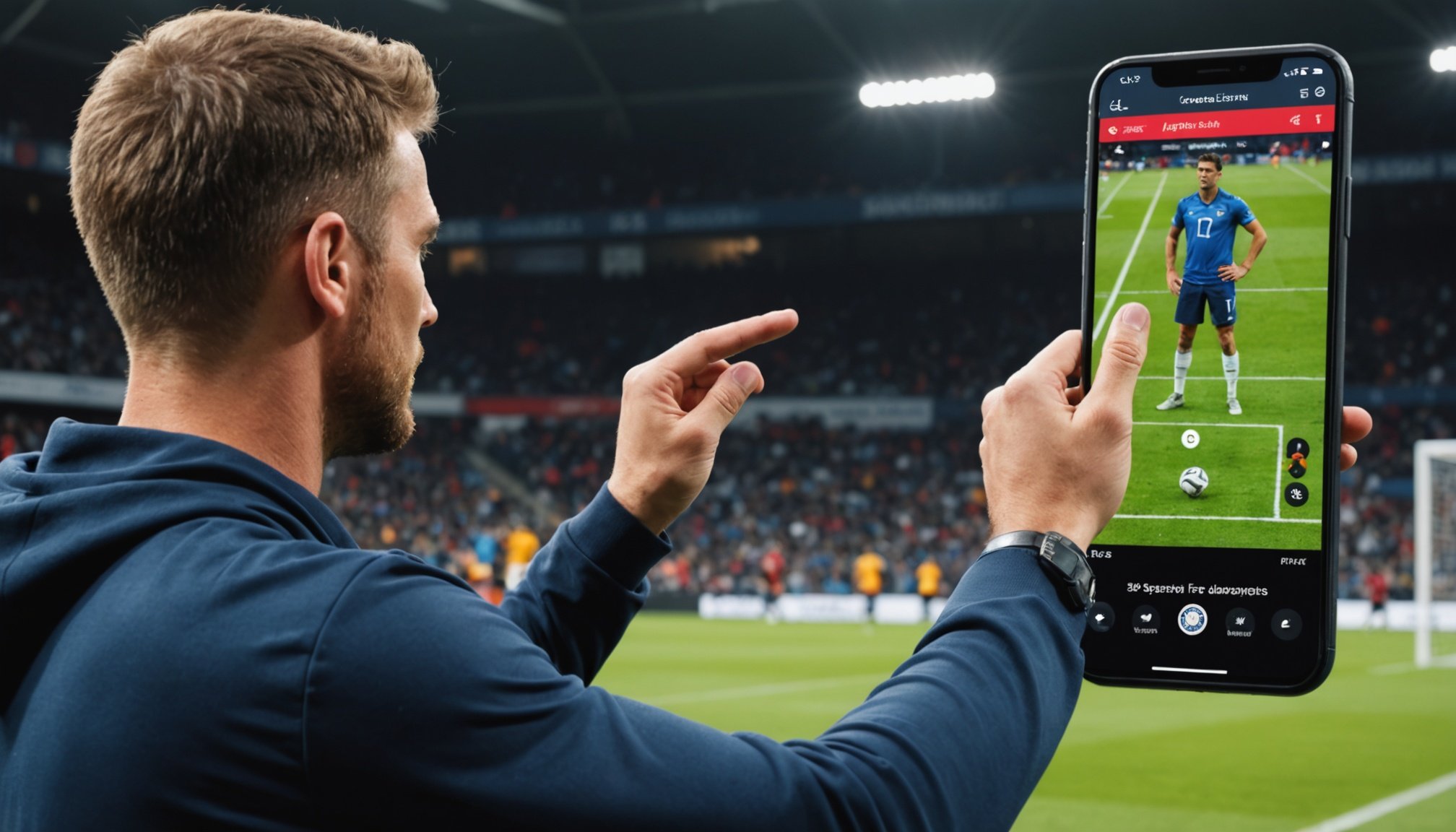Transforming Sports Coaching: The Game-Changing Impact of Augmented Reality on Real-Time Performance to Augmented Reality in Sports Coaching
Augmented reality (AR) is revolutionizing the sports coaching landscape by introducing a new dimension to athlete training. This technology enriches the coaching process by providing athletes and coaches with real-time data and visuals, significantly enhancing performance. Here’s how AR is transforming the way athletes train and compete.
How AR Technology Works in Sports
AR technology in sports involves the use of headsets, mobile applications, and smart glasses to integrate digital elements with the athlete’s environment. This integration allows for in-depth analysis of movement, technique, and performance metrics, offering a cutting-edge approach to traditional coaching methods.
Have you seen this : Unveiling cutting-edge innovations in oled technology: boosting visual display excellence
Key Components of AR in Sports
- Headsets and Smart Glasses: These devices enable athletes to receive real-time feedback and visual cues directly during training sessions. For instance, AR goggles can project trajectories and outcomes, acting as a personal and interactive tutor[1].
- Mobile Applications: These apps provide instant statistics and interactive content, allowing coaches to track player performance and make data-driven decisions. For example, mobile apps can offer real-time positional data, aiding in tactical awareness and skills refinement[1][2].
- Data Analytics: AR platforms utilize data analytics to optimize training regimens tailored to each athlete’s unique physiological and psychological needs. This data-driven approach helps in improving performance and reducing injury risks by emphasizing technique corrections[1].
Case Studies of AR in Real-Time Performance
Several professional sports teams have already integrated AR into their training programs, highlighting its immense benefits.
Football and Tactical Training
Professional football teams have used AR to simulate game scenarios and refine tactical plays. This allows athletes to practice strategic play without physical presence, effectively improving mental resilience and decision-making. For example, coaches can use AR to simulate opposing teams’ tactics, providing players with a comprehensive understanding of the game without stepping onto the field[1].
Also read : Elevate your organization with effective knowledge management
Handball and Immersive Training
In handball, teams like the French national team (Les Bleues) use AR and virtual reality (VR) to train in complex game scenarios. These immersive technologies help athletes develop their decision-making skills and react to multiple pieces of information simultaneously. This approach enhances their agility and versatility on the field[2].
Industry Trends in AR Adoption in Sports
The adoption of AR in sports is reshaping the landscape of athletic training and sports tech innovation.
Emerging Companies and Startups
Emerging companies and startups are playing a pivotal role in this technological evolution by developing specialized AR solutions for sports coaching. These innovators are creating systems that offer real-time feedback and analytics, transforming how coaches interact with athletes. For instance, certain startups provide wearable AR devices that project positional data directly onto a player’s visor, aiding in tactical awareness and skills refinement[1].
Integration with Other Technologies
AR is often integrated with other advanced technologies such as artificial intelligence (AI) and big data analytics. For example, Manchester City uses AI and big data to analyze opponents’ strategies, identify weaknesses, and develop tactical plans. This integration enhances the coaching process by providing a more comprehensive and data-driven approach to training and game strategy[4].
Future Predictions for AR in Sports Training
As AR technology becomes more sophisticated, we can expect significant advancements in sports coaching innovation.
Simulating Competitive Environments
One major prediction is the increased use of AR to simulate competitive environments. This allows athletes to practice strategic play without physical presence, effectively improving mental resilience. The ability to overlay digital information on physical actions can enhance techniques by providing immediate corrective feedback[1].
Personalized Training Regimens
AR, combined with AI and data analytics, will enable coaches to create highly personalized training regimens. By analyzing data on an individual player’s physical, mental, and emotional state, AR can adjust difficulty levels and target weak areas, leading to optimized performance and reduced injury risks[3][5].
Practical Insights and Actionable Advice
Here are some practical insights and actionable advice for coaches and athletes looking to integrate AR into their training programs:
Implementing AR in Training Programs
- Start with Simple Applications: Begin by using AR for basic training tasks such as technique analysis and real-time feedback. As you become more comfortable with the technology, you can move on to more complex applications like simulating game scenarios.
- Invest in Quality Hardware: Ensure that you have the right hardware, such as high-quality headsets or smart glasses, to deliver an immersive and interactive experience.
- Combine with Other Technologies: Integrate AR with other technologies like AI and big data analytics to get a more comprehensive view of athlete performance and to make data-driven decisions.
Example of a Successful AR Implementation
Coach Sandra Robertson from a professional football team shared her experience with AR: “Using AR to simulate opposing team’s tactics has been a game-changer. It allows my players to understand the game without stepping onto the field, which has significantly improved their decision-making and analytical skills.”[1]
Table: Comparison of Traditional Coaching Methods vs. AR-Enhanced Coaching
| Method | Description | Advantages | Disadvantages |
|---|---|---|---|
| Traditional Video Analysis | Reviewing game footage to analyze performance. | Provides detailed feedback on past performances. | Time-consuming, lacks real-time feedback. |
| Physical Demonstrations | Coaches demonstrating techniques in person. | Direct interaction between coaches and athletes. | Limited to the coach’s ability to demonstrate. |
| AR-Enhanced Coaching | Using AR to overlay digital information on physical environments. | Provides real-time feedback, simulates game scenarios, and offers personalized training. | Requires investment in hardware and software. |
| Wearable Tracking Devices | Using devices to track athlete performance metrics. | Provides real-time data on athlete performance. | Limited to quantitative data, lacks visual feedback. |
| Interactive AR Applications | Using AR apps for interactive training sessions. | Enhances engagement, provides immediate corrective feedback. | Requires technical setup and maintenance. |
Augmented reality is not just a tool; it is a pivotal component in modern sports coaching. By providing real-time data, simulating game scenarios, and offering personalized feedback, AR is transforming the way athletes train and compete. As this technology continues to evolve, we can expect even more innovative applications that will further enhance sports performance and fan engagement.
Quotes from Industry Experts
- “The immediacy of feedback provided by AR leads to faster learning and mastery of complex skills compared to traditional methods.” – Coach from a professional football team[1].
- “AR has allowed us to take our training to the next level by providing immersive and interactive experiences that go beyond what traditional tools offer.” – Coach Sandra Robertson[1].
Final Thoughts
The integration of AR into sports coaching is a significant step forward in the sports industry. It offers a more engaging, personalized, and data-driven approach to training, which can lead to improved performance, reduced injury risks, and enhanced fan engagement. As we move into the future, it will be exciting to see how AR continues to revolutionize the world of sports.











